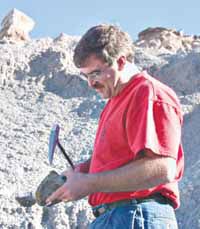| Reece Barrick, the new paleontologist at the College of Eastern Prehistoric Museum, examines a rock he uncovered at a local site. Barrick has spent numerous hours in scientific laboratories working with fossils. The prehistoric museum paleontologist will now have a chance to complete a lot more field work, something Barrick indicates he really enjoys. |
There he stood, near a gray hill with a rock hammer in one hand and what was seemingly a rock in the other. He was chipping at it, looking for parts of a fossil, while others around him were doing the same thing. A dinosaur dig is a team effort, and it was obvious Reece Barrick, the new paleontologist at the College of Eastern Utah Prehistoric Museum, was already part of the team.
“Utah is a wondrous place,” he said as he sat down on a ledge overlooking the desert. “For a geologist and someone who loves the outdoors it has so much diversity.”
The Iowa born scientist’s life has been full of diversity through travel and education. But his excitement has never been greater.
“The people who work at our museum are amazing,” he states. “Rather than a small college or small town museum, it is more like a regional museum, better than many big ones. That is largely due to the people who created it and are there now.”
Barrick has worked with fossil collections from across the world. That’s primarily because he has worked in a specialized field of paleontology, one that deals with stable isotopes.
“Obviously, I have spent a lot of time in the lab doing that work,” he commented. “But I really am looking forward to the field work, like what I am doing today.”
While being educated at Cornell College in Cedar Rapids, Iowa,with a dual major in biology and geology, Barrick hadn’t thought much about dinosaurs since he was a child.
“I had an interest then – you know, the Weekly Reader books and the plastic toys,” he noted. “When I became a teenager, all that fell behind me. Then I read a book while I was working on my B.A., a book called Hot Blooded Dinosaurs: A Revolution in Paleontology by Adrian Desmond. Suddenly, a whole new world opened up. Here was a field where there didn’t seem to be definitive answers, there was a lot to learn.”
Barrick went on to earn a master’s degree and a doctorate from the University of Southern California. Not coincidentally, His master’s thesis and doctoral dissertation tied together closely. His master’s thesis was about the temperature of ancient oceans, while his dissertation was concerned with the temperature variability within dinosaur skeletons.
To many Carbon County residents, the topic might sound dry and uninteresting. But according to Barrick, the matter is very important to the debate about whether dinosaurs are lizards or birds that still goes on among members of the scientific community. That is where the lab work comes in.
Most people have probably heard of radio isotopes. Radio isotopes are what scientists used to age date ancient remains. But stable isotopes are different. Stable isotopes can indicate the temperature of ancient items and remains during a certain time.
“What you can do with these type of isotopes tells us about various climatological and biological systems that existed,” explained Barrick. “That’s what I have been working on for years.”
Most of those years, 10 to be exact, were spent at North Carolina State University where he had a post doctoral fellowship and then became a visiting assistant professor.
“The first two were the fellowship, the last eight I was visiting. A long time to be visiting,” he quipped.
During that time he work with collections from all over the world, testing them. He also got to travel widely to places as diverse as Israel, Japan, Spain and Argentina, amongst a few.
But doing lab work and teaching, as exciting as it was, was not field work. And in big departments in big universities a lot of time is spent in meetings.
What he was looking for was the total experience that he could get when he applied for the position that was open in Carbon County.
“And it’s not just the field work here but the recreational opportunities available here as well,” he noted.
During the past few weeks, Barrick and his wife have done a bit of traveling in the area and the couple are fascinated by all that can be seen. But his wife wasn’t quite so sure about leaving a generally wet and green climate when they first came into Utah, driving along Interstate 70 from Grand Junction, Colo.
“When I first came here, I had driven down from Salt Lake in that beautiful canyon so I didn’t know what to expect when coming from the other way,” he related. “As we crossed the border, the land became more and more desolate and by the time we reached Green River she asked me if she would ever see a tree again. I kept telling her this was just the kind of country I wanted to be in because that is where my work would be. She was very glad when we drove over the hill and saw Price with all its trees and green areas.”
As for the future, Barrick predicts the museum will become better and better.
“I look at it today and can see some wonderful possibilities,” he said. “But you know when I realize what it all started with a little over 40 years ago and where it has progressed to, that is the amazing part. There is nothing we could ever do in the future that could diminish the accomplishments of those who started the whole thing.”
Then he got up off the ledge he was sitting on and his rock hammer in hand and rejoined the team members as they searched and dug for more signs of ancient life.

